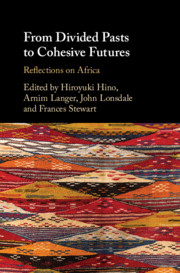Book contents
- From Divided Pasts to Cohesive Futures
- From Divided Pasts to Cohesive Futures
- Copyright page
- Contents
- Figures
- Tables
- Contributors
- Foreword
- Acknowledgments
- Introduction: Understanding Processes of Change in Social Cohesion: Learning from Comparative History
- Part I Social Cohesion in Africa: Case Studies of Past and Present
- 1 Kenya’s Four Ages of Ethnicity
- 2 Better Elections, More Deaths
- 3 Ethnicity, Citizenry, and Nation-Building in Tanzania
- 4 Identity, Inequality, and Social Contestation in the Post-Apartheid South Africa
- 5 Ethnicity, Development, and Social Cohesion in Africa
- Part II Policies and Institutions for Social Cohesion
- Part III Conclusions and Policy Recommendations
- Index
- References
5 - Ethnicity, Development, and Social Cohesion in Africa
Overview
from Part I - Social Cohesion in Africa: Case Studies of Past and Present
Published online by Cambridge University Press: 05 August 2019
- From Divided Pasts to Cohesive Futures
- From Divided Pasts to Cohesive Futures
- Copyright page
- Contents
- Figures
- Tables
- Contributors
- Foreword
- Acknowledgments
- Introduction: Understanding Processes of Change in Social Cohesion: Learning from Comparative History
- Part I Social Cohesion in Africa: Case Studies of Past and Present
- 1 Kenya’s Four Ages of Ethnicity
- 2 Better Elections, More Deaths
- 3 Ethnicity, Citizenry, and Nation-Building in Tanzania
- 4 Identity, Inequality, and Social Contestation in the Post-Apartheid South Africa
- 5 Ethnicity, Development, and Social Cohesion in Africa
- Part II Policies and Institutions for Social Cohesion
- Part III Conclusions and Policy Recommendations
- Index
- References
Summary
This chapter attempts to review comprehensively the interconnection between ethnicity, development and social cohesion with special reference to modern history and contemporary circumstances in Africa. Ethnicity is a historical construct, changeable in relation to the political economy of the modern state. At the same time, ethnicity is a given and overwhelming reality for people, thereby reciprocally affecting politics and economy. Ethnicity dynamically changes in accordance with vertical and horizontal cleavages and thus intra- and inter-ethnic relations and given competitive situation for limited resources in the state and market has tended to result in exclusionary ethnic cohesion and political tribalism in Africa. African ethnicity and its interconnection with development and social cohesion should be understood, referring to phenomena occurring in the contemporary context of globalization: increasing migration causing ethnic diversity and exclusionary reactions, increasing corruption and decline of trust in the state, international spread of organized crimes, increasing incapability of national governments towards global crisis, destructive impact of unregulated markets, and yawning inequality as a global issue. We then examine five critical issues with grave political and economic implications: building democratic institutions, constitutions and governance devolution, media and education, land and territory, natural resources and foreign investment. We conclude the chapter with argument that achieving growth with equity and social cohesion through overcoming relevant problems is not unique challenge to Africa in this acceleratingly globalizing world.
Keywords
- Type
- Chapter
- Information
- From Divided Pasts to Cohesive FuturesReflections on Africa, pp. 161 - 190Publisher: Cambridge University PressPrint publication year: 2019



